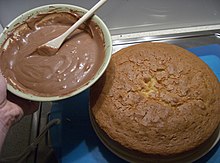Glaze (kitchen)
A glaze is a coating produced by glazing on desserts , cakes , tarts and pastries .
Icing
Sugar icings are made from powdered sugar , which is mixed with liquid to form a smooth mass that solidifies when dried . Depending on the recipe, the glaze is enriched with other ingredients and flavors.
- Water glaze or icing consists only of powdered sugar and water or fruit juice. It is sometimes warmed up a little before application. Water glaze is hard and has a matt finish.
- For egg white icing , the water is replaced by raw egg white. Condé glaze is protein glaze with finely chopped almonds.
- Splash glaze is a smooth but not too thin egg white glaze with a little lemon juice. It is used to decorate and label cakes and tarts with the piping bag .
- Fondant (melting glaze) is a boiled-down sugar solution ( sugar syrup ) of a spreadable consistency. For production, the sugar solution is boiled to a weak or strong flight and then tableted until it cools. For processing, the base mass is heated and diluted with water or egg white. Fondant is used as a glaze for pastries and cakes and as a filling for pralines and candies .
All glazes can be varied with lemon juice, spirits, cocoa , instant coffee, etc.
Glazes containing cocoa
Couverture , also known as chocolate coating, is a chocolate with a high cocoa butter content that is particularly suitable for coating baked goods. The legislator has set minimum requirements for the ingredients.
Ganache is a coating made from couverture and cream to which sugar and flavorings are added depending on the application. The cream is heated and the couverture is added. The ratio of couverture to cream depends on the intended use and the desired consistency.
Fat glaze is a chocolate-like coating made of vegetable fat and sugar with additives such as cocoa powder , milk powder or hazelnut mass . Production is essentially the same as that of chocolate, but with certain simplifications; the ingredients are mixed andemulsifiedwith lecithin . The glaze is not hardened by drying, but is due to the solidification of the fat during cooling.
In Germany, cooking chocolate is a thin-bodied chocolate glaze that is cooked from cocoa powder, sugar, water and flavors to form a coating that can be coated. It is used, among other things, to cover cakes, desserts and carrots .
Chocolate dunk mass
In the GDR , dunking and enrobing compounds were used to coat pralines, confectionery products and ice cream. In the pastry shop , couverture and chocolate dunking were used . Their composition was regulated by law to the effect that at least 33% cocoa mass and max. 50% sucrose were allowed. As a substitute for cocoa butter , up to 7% hard edible fat could be added.
See also
Individual evidence
- ↑ a b IREKS Arkady Institute for Bakery Science (ed.): IREKS ABC of the bakery. 4th edition. Institute for Bakery Science, Kulmbach 1985
- ↑ Gerhard Eisenbrand, Peter Schreier (ed.): Römpp-Lexikon Lebensmittelchemie . Food law edited by Alfred Hagen Meyer. 2nd, completely revised and enlarged edition. Thieme, Stuttgart 2006, ISBN 3-13-143462-7 , keyword “coating compounds ”, p. 1210 ( limited preview in Google Book search).
- ^ Raw materials for food production , VEB Fachbuchverlag Leipzig 1988

